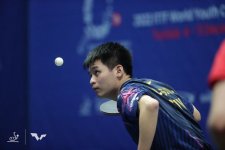Mytischtennis has made a very intersting interview with Liu Guoliang where he answers to very intersting questions we asked ourselves or we debated on the forum.
http://stigatabletennis.com/en/2015/01/mytischtennis-interview-with-stiga-coach-liu-guoliang/
The members of MyTischTennis.de has asked the Head Coach of the Chinese National Team Liu Guoliang 15 questions about Table Tennis in China and the success of the Chinese National Team.
What do you think is the main reason for the Chinese success compared to other countries? What do you practice differently than the rest of the world?
It may be a result of our national-wide culture of table tennis. We have tremendous people fond of table tennis. It’s a popular sport with solid mass foundation of people. More people play it, namely a higher endeavor it receives. That’s why greater table tennis players are emerging continuously with an even better performance.
Differences could be many. Even in China, every single coach has his/her individual principal and style, not to mention the difference between countries. Besides, every country has its own culture, and the table tennis culture is different among countries. So they have different expectations and starting points. For us, we are heading to champion and, leading the global development of table tennis.
What is your opinion about the regulations that strictly limit the amount of Chinese players at the most important tournaments – e.g. the Olympics, World Championships or World Cup?
Yes, there is influence from the amount for Chinese players. Well, I think the regulations are based on a fair point for the sport. Besides, if regulation requires any adaptive process, then it’ll be the same process for all the players.
Many athletes – born and grown up in China – are now playing in national teams of different countries. What do you think about this situation?
It normally happens, because of the heavy competition in China. Chance of playing for China is slight for some players who desire achieving a personal dream. Their choice of playing for foreign country has positive influence on the national level. But for a long term true strong, domestic grown players deserve to be depended on. Because non-domestic players may eager for quick success and take a short cut. This is not a good idea for long-term development plan.
How many players belong to the different squads (national team A, B, C, provincial and talent squads) and why don’t the B- and C-players participate at European tournaments, where they would have a good chance to win and contribute to refinancing?
National team A has more than 20, and the B squad has a close to 20.
We have comparatively many domestic matches, for example, CTTSL, CTTAL and CTTBL. Plus a consideration of international matches, confliction happens on schedule. On the other hand, a gap between European tournaments and our domestic tournaments is also a reason.
Now there are many matches: YOG, WJTTC, AJTTC and other league matches. Some stronger members of B squad take part in CTTSL and CTTAL. So I think there’s enough plenty opportunities for them to perform.
There are a lot of different types of players in the Chinese national team – shakehand and penholder players, left and right handers. But you can’t find a Chinese defensive player among the male world leaders. How do you assess the opportunities for defensive players in China? Is it possible for them to reach the national team?
Naturally, male defensive player has to meet a fierce challenge. It’s even harder now when competition goes more intense, not to mention such a player in China national male squad. The best defensive male player for me is JOO Se Hyuk from Korea because of his notable performance and for so long time.
Actually we have 2 choppers, Ma Te and Liu Yi. They are at a disadvantage within the team. But there’s a place for them in the international table tennis.
There are no Chinese players at the World Tour Grand Finals. Why didn’t they fulfill the qualification criteria? Why did the persons responsible think that this tournament isn’t worthwhile?
We want to fulfill the ITTF tournaments, somehow there’s a comparative intense match schedule: domestic tournaments, commercial matches and international matches, etc.. The ITTF schedules partly drops limit on not only us, so the international matches become optional when personal match schedule allows. The limitation is not only the China, but also player of the greatest level such as Boll. This may be a considerable question for ITTF, if a rule limits the best player or the team on schedule.
How do you prepare your team in the last practice unit prior to a final versus Germany?
Strengthening ourselves and studying others. This differs from players to their competitors.
Every competition with Germany ignites our flames. They are our strongest opponent with a full combat effectiveness. We take every preparation cautiously and carefully. Though we always win the final success, the process is not easy and smooth. In the finals in Tokyo 2014, Ovtcharov pressured us in an early stage especially after winning Zhang Jike.
How many hours a week does a Chinese A-squad-player spend with fitness and athletic training – off the table?
Around 40 minutes after daily training. On some Saturdays, we spend a half daytime on physical training.
Most Chinese players are very forehand orientated. Would you advise the Europeans to play this way as well?
It’s not enough to only focus on forehand in the nowadays table tennis trend. Without all-round trained skills, a weakness is easily exposed. So I think a balance between forehand and backhand should be necessarily advised.
One innovation of the last years was the backhand “banana flip”. Is there a new big innovation coming in the near future? What could it be?
“Banana flip” became one of mainstream techniques from the beginning of the innovation to even now. In the future it may still have its own place. But I think emerge of more innovations will contribute to the development of world table tennis.
Which Chinese athletes are playing with STIGA blades? Will the national team members play with the new STIGA carbon blades (Carbonado 145 and Carbonado 190) in the future?
STIGA has been an official supplier of the China national table tennis team for many years. A deep friendship is therefore established. STIGA table tennis blade has an extreme high reputation worldwide for dozens of years. So our cooperation becomes even closer during these years. We don’t have a detail investigation, but toughly I estimate, 2 thirds of our players are using STIGA, because we are under an official cooperation. Besides some very few exceptional needs, I think STIGA has special characteristics.
As far as I know, Fan Zhendong is using it. He feels quite good, because the new blade enables him stronger power. I think it’s possible for our team members as long as a blade matches the trend of table tennis development and meets and need of players, especially for those key leading players. Their approval will lead other young members’ follow.
What is your favorite training exercise?
I think the purpose of training is to prepare for match, so the point is how to combine elements of match into the training. This enables training to become better targeted.
What is your opinion about the plastic ball – compared to the celluloid one?
I think it’s positive in an overall consideration, because celluloid ball contains a dangerous possibility. With a respect of safety and health, plastic ball is better for sure. It is under a developing stage, so there may be a big challenge for ball producers.
Who are/were the five best non-chinese players – from the beginning of your career until today? Who is the best player of the world for you at the moment (Chinese included)?
(Oh, five…) Waldner, Persson, Gatien, KIM Taek Soo, and Rosskopf.
(Active players?) For me, Zhang Jike and Ma Long are better in domestic, and Boll and Ovtcharov are better in overseas.
What is most important to become a successful player?
Love. Love drives endeavor and brings return. This is the most important regardless of talent or level of a player.
http://stigatabletennis.com/en/2015/01/mytischtennis-interview-with-stiga-coach-liu-guoliang/
The members of MyTischTennis.de has asked the Head Coach of the Chinese National Team Liu Guoliang 15 questions about Table Tennis in China and the success of the Chinese National Team.
What do you think is the main reason for the Chinese success compared to other countries? What do you practice differently than the rest of the world?
It may be a result of our national-wide culture of table tennis. We have tremendous people fond of table tennis. It’s a popular sport with solid mass foundation of people. More people play it, namely a higher endeavor it receives. That’s why greater table tennis players are emerging continuously with an even better performance.
Differences could be many. Even in China, every single coach has his/her individual principal and style, not to mention the difference between countries. Besides, every country has its own culture, and the table tennis culture is different among countries. So they have different expectations and starting points. For us, we are heading to champion and, leading the global development of table tennis.
What is your opinion about the regulations that strictly limit the amount of Chinese players at the most important tournaments – e.g. the Olympics, World Championships or World Cup?
Yes, there is influence from the amount for Chinese players. Well, I think the regulations are based on a fair point for the sport. Besides, if regulation requires any adaptive process, then it’ll be the same process for all the players.
Many athletes – born and grown up in China – are now playing in national teams of different countries. What do you think about this situation?
It normally happens, because of the heavy competition in China. Chance of playing for China is slight for some players who desire achieving a personal dream. Their choice of playing for foreign country has positive influence on the national level. But for a long term true strong, domestic grown players deserve to be depended on. Because non-domestic players may eager for quick success and take a short cut. This is not a good idea for long-term development plan.
How many players belong to the different squads (national team A, B, C, provincial and talent squads) and why don’t the B- and C-players participate at European tournaments, where they would have a good chance to win and contribute to refinancing?
National team A has more than 20, and the B squad has a close to 20.
We have comparatively many domestic matches, for example, CTTSL, CTTAL and CTTBL. Plus a consideration of international matches, confliction happens on schedule. On the other hand, a gap between European tournaments and our domestic tournaments is also a reason.
Now there are many matches: YOG, WJTTC, AJTTC and other league matches. Some stronger members of B squad take part in CTTSL and CTTAL. So I think there’s enough plenty opportunities for them to perform.
There are a lot of different types of players in the Chinese national team – shakehand and penholder players, left and right handers. But you can’t find a Chinese defensive player among the male world leaders. How do you assess the opportunities for defensive players in China? Is it possible for them to reach the national team?
Naturally, male defensive player has to meet a fierce challenge. It’s even harder now when competition goes more intense, not to mention such a player in China national male squad. The best defensive male player for me is JOO Se Hyuk from Korea because of his notable performance and for so long time.
Actually we have 2 choppers, Ma Te and Liu Yi. They are at a disadvantage within the team. But there’s a place for them in the international table tennis.
There are no Chinese players at the World Tour Grand Finals. Why didn’t they fulfill the qualification criteria? Why did the persons responsible think that this tournament isn’t worthwhile?
We want to fulfill the ITTF tournaments, somehow there’s a comparative intense match schedule: domestic tournaments, commercial matches and international matches, etc.. The ITTF schedules partly drops limit on not only us, so the international matches become optional when personal match schedule allows. The limitation is not only the China, but also player of the greatest level such as Boll. This may be a considerable question for ITTF, if a rule limits the best player or the team on schedule.
How do you prepare your team in the last practice unit prior to a final versus Germany?
Strengthening ourselves and studying others. This differs from players to their competitors.
Every competition with Germany ignites our flames. They are our strongest opponent with a full combat effectiveness. We take every preparation cautiously and carefully. Though we always win the final success, the process is not easy and smooth. In the finals in Tokyo 2014, Ovtcharov pressured us in an early stage especially after winning Zhang Jike.
How many hours a week does a Chinese A-squad-player spend with fitness and athletic training – off the table?
Around 40 minutes after daily training. On some Saturdays, we spend a half daytime on physical training.
Most Chinese players are very forehand orientated. Would you advise the Europeans to play this way as well?
It’s not enough to only focus on forehand in the nowadays table tennis trend. Without all-round trained skills, a weakness is easily exposed. So I think a balance between forehand and backhand should be necessarily advised.
One innovation of the last years was the backhand “banana flip”. Is there a new big innovation coming in the near future? What could it be?
“Banana flip” became one of mainstream techniques from the beginning of the innovation to even now. In the future it may still have its own place. But I think emerge of more innovations will contribute to the development of world table tennis.
Which Chinese athletes are playing with STIGA blades? Will the national team members play with the new STIGA carbon blades (Carbonado 145 and Carbonado 190) in the future?
STIGA has been an official supplier of the China national table tennis team for many years. A deep friendship is therefore established. STIGA table tennis blade has an extreme high reputation worldwide for dozens of years. So our cooperation becomes even closer during these years. We don’t have a detail investigation, but toughly I estimate, 2 thirds of our players are using STIGA, because we are under an official cooperation. Besides some very few exceptional needs, I think STIGA has special characteristics.
As far as I know, Fan Zhendong is using it. He feels quite good, because the new blade enables him stronger power. I think it’s possible for our team members as long as a blade matches the trend of table tennis development and meets and need of players, especially for those key leading players. Their approval will lead other young members’ follow.
What is your favorite training exercise?
I think the purpose of training is to prepare for match, so the point is how to combine elements of match into the training. This enables training to become better targeted.
What is your opinion about the plastic ball – compared to the celluloid one?
I think it’s positive in an overall consideration, because celluloid ball contains a dangerous possibility. With a respect of safety and health, plastic ball is better for sure. It is under a developing stage, so there may be a big challenge for ball producers.
Who are/were the five best non-chinese players – from the beginning of your career until today? Who is the best player of the world for you at the moment (Chinese included)?
(Oh, five…) Waldner, Persson, Gatien, KIM Taek Soo, and Rosskopf.
(Active players?) For me, Zhang Jike and Ma Long are better in domestic, and Boll and Ovtcharov are better in overseas.
What is most important to become a successful player?
Love. Love drives endeavor and brings return. This is the most important regardless of talent or level of a player.














